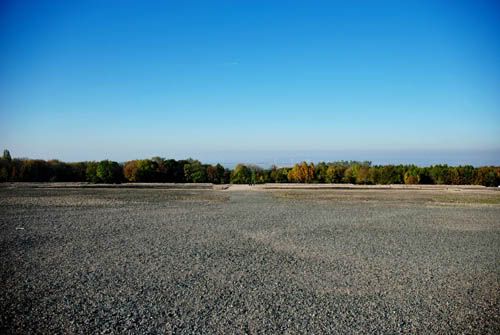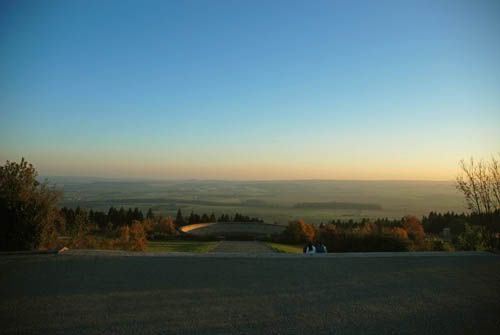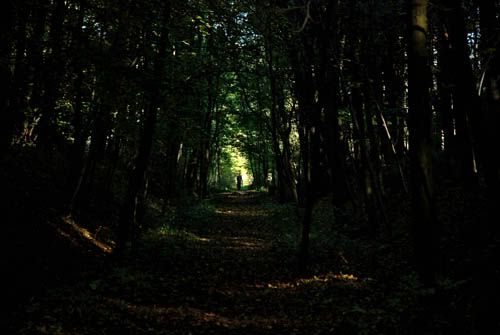 View from the concentration camp to the North
View from the concentration camp to the North1st act: Carefully set stage
The Nazi decision to locate the concentration camp on the hill, is probably primarily bound to technical and military matters. But a detail related to the topography of the site and its association with the urban center of Weimar, could be described with theatrical terms: The camp, almost (yet not) on top of the hill, is overlooking to the North, turning its back to Weimar. Once in the camp, one has left Weimar behind, and vice-versa: this is an intentionally hidden, secret topos, set to operate in the shadow.

The memorials' erection during the DDR era completely reversed the notion of the hidden, virtually non-existent. The camp, declared monument to atrocities, but also to resistance and human dignity, ought to be brought to light. That's why the memorial complex (with a size comparable to the concentration camp itself) follows exactly the opposite logic: turns its back to the camp - or what had been left out of it, and faces Weimar in a pompous, unmediated and triumphant way. With this gesture, the semantics of the KZ site are reevaluated, transliterated, and the spot gains a new identity, now emphatically projecting post-war socialist ideals to the city. Additionally, the monumental mass of the “Gedenkstätte“ tower, dominant and visible from all surrounding areas, is not simply calling for, but demanding the viewer's attention.

View from the socialist monument to the South
2nd act: Even if you didn't know, now you shall see...The memorials' erection during the DDR era completely reversed the notion of the hidden, virtually non-existent. The camp, declared monument to atrocities, but also to resistance and human dignity, ought to be brought to light. That's why the memorial complex (with a size comparable to the concentration camp itself) follows exactly the opposite logic: turns its back to the camp - or what had been left out of it, and faces Weimar in a pompous, unmediated and triumphant way. With this gesture, the semantics of the KZ site are reevaluated, transliterated, and the spot gains a new identity, now emphatically projecting post-war socialist ideals to the city. Additionally, the monumental mass of the “Gedenkstätte“ tower, dominant and visible from all surrounding areas, is not simply calling for, but demanding the viewer's attention.

Pathway leading to KZ - One of the secret burial places for German POWs,
shortly after 1945.
3rd act: Discovering more bodiesshortly after 1945.
After 1989, the role of the camp under Red Army rule was brought to light: The German war prisoners' fate, neither carefully and secretly implemented nor – of course - triumphantly announced, was roughly covered by trees, scattered deep in the woods north-east of the Nazi camp – i.e, made even more invisible to the public eye.

There is even another metaphorical connection between these three stages, implemented in a german saying: Weimar hat Buchenwald nicht verhindert!
ReplyDeleteMy english is really bad, but I would translate it into: Weimar didnt't prevent Buchenwald!
Therefor the staging of Buchenwald in all three stages is directly related to Weimar - and vice versa.